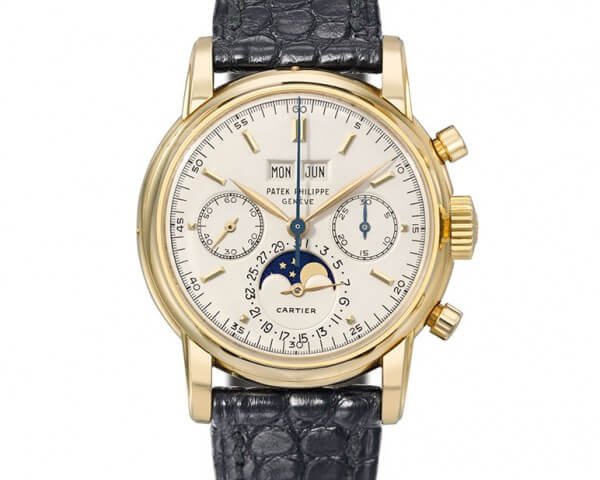When Aurel Bacs brought his gavel down on the last lot in Christie’s November 11th sale, he did so to a standing ovation. Cleary moved, the Geneva auction house’s international head of watches had brought the session to a close on an incredible total of CHF 40.3 million. The marathon had begun the previous evening with a Rolex themed sale (see “Lesson One” sends Rolex into orbit). Bacs’ departure at the end of the year had been announced in a press release a few weeks earlier, and the public, journalists and his colleagues were there to applaud his final appearance at the rostrum in Geneva. This was just one of the highlights in a sale which saw a Breguet grande complication watch made in 1831 go to the Breguet Museum in Paris (see “This watch was meant for the Breguet Museum!”) , and two Patek Philippe wristwatches, references 2499 and 1563 – the two highest-priced lots in the sale – fetch CHF 1.98 million and CHF 1.44 million respectively. Apart from the usual stars, lots by Panerai and Longines drew more interest than expected among collectors.

Record prices
Both Christie’s and Sotheby’s achieved record results for their sales. Christie’s achieved the highest result ever for a series of watch sales with CHF 28.2 million realised at its Important Watches auction. Added to the CHF 12 million of the Rolex sale, this gave a combined total of CHF 40.27 million with 92% sold by lot. As for Sotheby’s, it set a record for the Geneva salesroom with CHF 10.9 million realised and selling 84% by lot. Antiquorum, meanwhile, totalled CHF 7.6 million with 75% of lots sold. Three items went over the million mark. Two at Christie’s, namely the Patek Philippe pink gold perpetual calendar chronograph with moon phases Ref. 2499 made in 1957 (sold for CHF 1,985,000, est. CHF 1,000,000-1,500,000) and the Patek Philippe yellow gold split-seconds chronograph Ref. 1563 made in 1947 (sold for CHF 1,445,000, est. CHF 800,000-1,400,000), and one at Sotheby’s: the Breguet half quarter repeater with equation of time, calendar and moon phases Ref. 4691 made in 1831 (sold for CHF 1,025,000, est. CHF 600,000-1,000,000).
There could have been a fourth, as Christie’s was also offering the “twin sister” to the Patek Philippe Ref. 2499. This time in yellow gold and manufactured in 1966, it was actually made for Cartier whose name was added at the 6 o’clock position, alongside that of the Geneva Manufacture. A detail which, though “probably unique” according to Christie’s, failed to excite bidders. It sold for CHF 941,000 (est. CHF 500,000-800,000) which, while still a high price, is CHF 1,000,000 under the session’s top-priced lot. Five other watches (not including the Rolex themed sale) exceeded CHF 500,000 – four at Christie’s and one at Antiquorum, namely a Patek Philippe tourbillon minute repeater perpetual calendar Ref. 5016 which went for CHF 723,750 (est. CHF 450,000-650,000), setting a record for this model.
The keys to success
As well as the traditional headliners, bidders seemed to have their sights trained on some promising names, from a collector’s point of view that is. All three auction houses proposed Longines watches that far exceeded their pre-sale estimates, including a 1950 steel flyback chronograph with central minute register that fetched CHF 46,250 (est. CHF 8,000-12,000) and a pink gold chronograph from 1947, sold “as found” (oxidation on half the case) that went for CHF 31,250 (est. CHF 10,000-15,000). “Although it does depend on the models, certain items in perfect condition, particularly the movement, can achieve respectable results,” commented Geoffroy Ader, head of watches at Sotheby’s.
Panerai proved to be another high-flyer. Christie’s brought the hammer down on a steel diver’s watch manufactured in the 1940s for CHF 329,000 (est. CHF 65,000-95,000) while a Marina Militare, made by Rolex for Panerai circa 1955, went for CHF 245,000 (est. CHF 80,000-120,000). Could these two brands one day reach the same heights as Patek Philippe and Rolex today? “Three criteria determine how successful a brand is at auction,” observed a connoisseur of the market. “The first is longevity. A brand must have at least 120 years to its name. The second is stability, meaning a company which has never ceased production or faded into obscurity for a number of years. The third is consistent quality.” Without making any predictions, it seems both Longines and Panerai meet these conditions. Then it’s a question of what sets buyers’ pulses racing.
While wristwatches pulled in the bids, pocket watches and desk clocks failed to find favour among buyers, a trend regrettably confirmed from one season to the next. All the auction houses have borne the brunt, though perhaps none more so than Antiquorum. A good third of the 150 or so unsold lots were vintage pieces. “As a general rule, quality sells well,” noted Julien Schaerer, managing director and senior watch expert in Geneva. “However, predicting how vintage pieces will perform isn’t easy, given the difficulty of reading trends in this domain.” The auction house was the only one to propose a large number of pocket watches and desk clocks, in addition to snuff boxes. A risk true enthusiasts cannot praise too highly.
“Lesson One” sends Rolex into orbit
“This watch was meant for the Breguet Museum!”




















